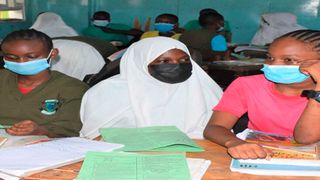
Pupils at Sparki Primary in class after schools resumed for the third term on January 3, 2022.
| Wachira Mwangi | Nation Media GroupNews
Premium
Despite fears, all is set for junior secondary roll-out
What you need to know:
- KICD and publishers are preparing learning and teaching materials for Grade Seven.
- The number of learners joining secondary schools has been on the rise every year.
Preparations for the transition to junior secondary school in January next year are in top gear despite concerns by some stakeholders about the roll-out of the competency-based curriculum (CBC) .
Kenya Institute of Curriculum Development (KICD) and publishers are preparing learning and teaching materials for Grade Seven. The writing started late last year, following the release of the curriculum designs for junior secondary. Learners currently in Grade Five will be the first cohort to join junior secondary next year.
Learners’ and teachers’ books will be submitted for evaluation in March. KICD boss Prof Charles Ong’ondo told Nation that curriculum designs for Grade Eight and Nine are also ready.
“We’re in the process of adapting the designs for special needs education. After evaluating Grade Seven, we’ll be calling for books for Grade Eight,” he said, adding, the curriculum designs will be uploaded in May to give publishers ample time to produce the books.
The materials are usually evaluated by teachers during school holidays. Schools are scheduled to close form March 4 to April 25. The seven-week holiday is the longest during the second year of a crash programme. Learners in junior secondary will be exposed to subjects that have been re-organised and some renamed.
There will be both core and optional subjects.
“Learners in junior secondary undergo a rigorous career guidance programme and are exposed to the related learning areas to enable them make informed choices as they transit to senior school,” the Basic Education Curriculum Framework reads.
Infrastructural shortcomings
Junior secondary will have 12 core subjects—English, Kiswahili or Kenyan Sign Language, mathematics, integrated science, health education, pre-technical and pre-career education, social studies, religious education, business studies, agriculture, life skills and sports and physical education.
Information and Communication Technology (ICT) will be integrated and used as a delivery tool for all the subjects. Optional subjects will be visual arts, performing arts, home science, computer science, foreign languages (German, French, Mandarin and Arabic), Kenyan Sign Language and indigenous languages.
Kenya Publishers Association Chairman Lawrence Njagi told Nation publishers were finding it a challenge to write the new books because “it’s completely different because of the CBC approach [and] calls for more editorial involvement,” he said.
According to Elimu Yetu Coalition National Coordinator Joseph Wasikhongo, some of the apprehension stems from the perception of exclusion of some stakeholders. In December, primary school teachers called for the domiciling of junior secondary in primary schools, contrary to recommendations to place it in secondary schools by a CBC implementation task force
Kenya National Union of Teachers National Advisory Council instructed national officials to petition the Education ministry, arguing that secondary schools are overwhelmed by infrastructural and discipline shortcomings.
Building 10,000 new classrooms
They blamed the crisis on the 100 per cent transition policy from primary to secondary schools. The congestion in secondary schools has been occasioned by a mismatch in infrastructure and enrolment where learners from 23,000 public and 11,000 private primary schools exit every year to be admitted to 10,359 public and 1,600 private secondary schools.
The number of learners joining secondary schools has been on the rise every year. According to data from the Economic Survey, 2021, enrolment in secondary schools jumped from 2,720,600 in 2016 to 3,520,400 in 2020, while only 520 new public schools have been built and 49 private ones shut down.
The government has allocated Sh8 billion to build 10,000 new classrooms in secondary schools. The first phase will see 6,500 new classrooms built in 6,371 schools. Private investors are also expected to help alleviate the problem.
Another sticking point is how learners will be placed in junior secondary. Whereas it is has been clarified that scores from the formative and summative assessments will be used, the Ministry of Education has never been clear whether the current categorisation of schools will exist.
There has always been stiff competition for places in national, extra-county and well-performing county schools which have better learning facilities than sub-county schools. The task force recommends that most of the learners attend day schools at junior secondary.
“Shouldn’t we have first equalised schools in terms of equipment and funding? I’m of the view that mixing of Kenyans from different places is a good thing. Otherwise, they will only know about their villages. This is utterly dangerous,” a lawyer, Jorum Mwaniki said.





